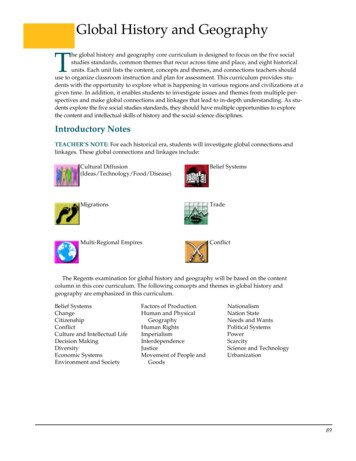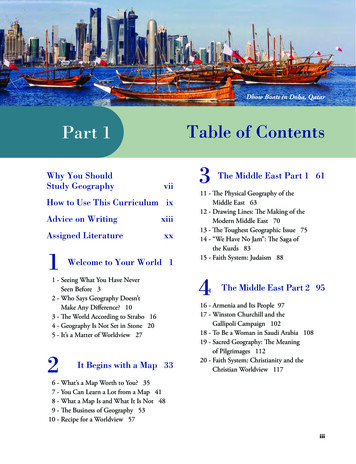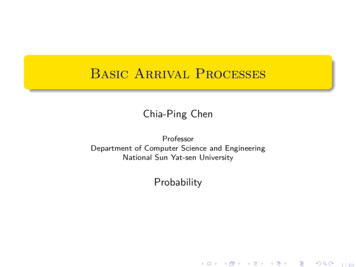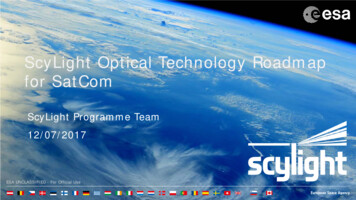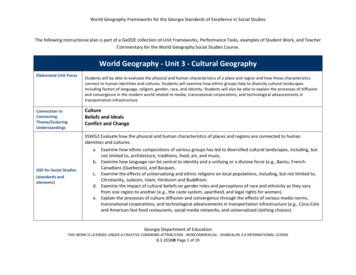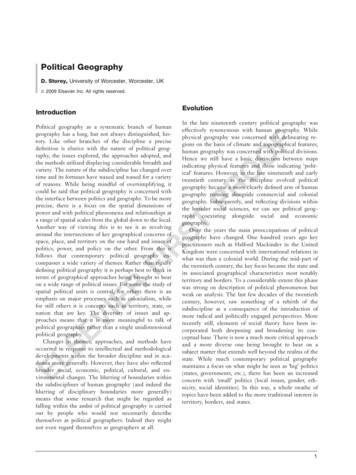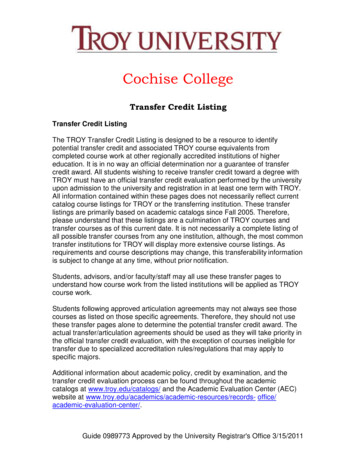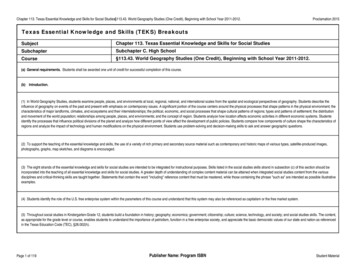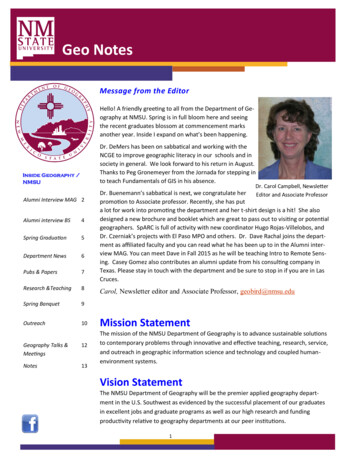
Transcription
Geo Notes: the Geography NewsletterGeo NotesMessage from the EditorHello! A friendly greeting to all from the Department of Geography at NMSU. Spring is in full bloom here and seeingthe recent graduates blossom at commencement marksanother year. Inside I expand on what’s been happening.Dr. DeMers has been on sabbatical and working with theNCGE to improve geographic literacy in our schools and insociety in general. We look forward to his return in August.Thanks to Peg Gronemeyer from the Jornada for stepping into teach Fundamentals of GIS in his absence.Inside Geography /NMSUDr. Carol Campbell, NewsletterAlumni Interview MAG 2Dr. Buenemann’s sabbatical is next, we congratulate herEditor and Associate Professorpromotion to Associate professor. Recently, she has puta lot for work into promoting the department and her t-shirt design is a hit! She alsodesigned a new brochure and booklet which are great to pass out to visiting or potentialgeographers. SpARC is full of activity with new coordinator Hugo Rojas-Villelobos, andDr. Czerniak’s projects with El Paso MPO and others. Dr. Dave Rachal joins the department as affiliated faculty and you can read what he has been up to in the Alumni interview MAG. You can meet Dave in Fall 2015 as he will be teaching Intro to Remote Sensing. Casey Gomez also contributes an alumni update from his consulting company inTexas. Please stay in touch with the department and be sure to stop in if you are in LasCruces.Alumni interview BS4Spring Graduation5Department News6Pubs & Papers7Research &Teaching8Spring Banquet9Outreach10Mission StatementGeography Talks &Meetings12Notes13The mission of the NMSU Department of Geography is to advance sustainable solutionsto contemporary problems through innovative and effective teaching, research, service,and outreach in geographic information science and technology and coupled humanenvironment systems.Carol, Newsletter editor and Associate Professor, geobird@nmsu.eduVision StatementThe NMSU Department of Geography will be the premier applied geography department in the U.S. Southwest as evidenced by the successful placement of our graduatesin excellent jobs and graduate programs as well as our high research and fundingproductivity relative to geography departments at our peer institutions.1
VOLUME 4, ISSUE 2Alumni Updates: Master of Applied GeographyDr. David M. Rachal: Class of 2007A.B.Professional Geomorphologist,Affiliated Geography Faulty at NMSUWhat was your specific program or focus of study?My focus of study was physical geography and the application of geospatial technologies. I was interested inusing GIS and remote sensing techniques to study theaffects of climate change earth surfaces processes.Who was your major advisor? Describe what yourC.thesis was about and your approach.!!Dr. Dugas was my major advisor. My master’s researchdealt with how climatic fluctuations influenced dunepattern development at the White Sands NationalMonument. I used ArcGIS 8.3 to map 14,000 individualdune crests in a 72-km2 area over a 60-year period inthe monument. As I reflect on that experience, I amsurprised that I didn’t development carpal tunnel syndrome from clicking the mouse over one million times.That was an insane endeavor. Our results show thatthe White Sands Dune Field rapidly adjusts to changesin climate over very short periods of time. During decades with above normal precipitation, the dune field!(A) Soils fieldwork in Botswana. Photo was taken in 2007. (B) Last Sumwould become more organized forming a dune patternmer at the Taj Mahal. (C) Photo taken in 2010 at Machu Picchu.that consisted of longer, less sinuous dunes. Duringdecades with below normal precipitation, the dunefield would become more fragmented forming a dune pattern that consisted of more individual dune crests that were highly sinuous. We published our results in Physical Geography in 2009.Did anyone else play a role in your work?Personal at the White Sands Missile Range and White Sands National Monument were both very generous in providing me all oftheir historic aerial photos. Without that photo archive, I could not have completed my thesis project.What was the new innovation of the day (time?).I used ArcGIS 8.3, but object based image analysis was also a hot technique during that time.What did you do when you left NMSU?After completing my masters, I finished my Ph.D. at NMSU in the Department of Plant and Environmental Science under Dr.Monger (i.e. The Mongersol). After that I started a geomorphology consulting company where I help cultural resource management firms locate and evaluate cultural deposits in southern New Mexico.Is there any technique or approach you used in thesis/grad work that was particularly beneficial later?What I learned from my brief tenure in the geography department was a workflow. The ability to find data, such as air photosor remotely sensed imagery, plug them into GIS or ERDAS for further analysis and generate maps based on those results. I usethis workflow on a daily basis.2
VOLUME 4, ISSUE 2Alumni Updates MAG Continued .How has your geography degree helped you?The MAG program has provided me with a ton of teaching experience, which has helped me with my communication skills. Theprogram also got me thinking about how processes can be observed at scales ranging from microscopic to continental and produce broad geographic patterns. Finally, Dr. Dugas’ geomorphology class, along with other courses in the geography department, got me thinking of landforms as seen from aerial photographs and satellite imagery and how landforms are the result oflarge-scale geologic processes. All of this has helped me become a better geomorphologist.What are you doing these days? What’s next?I am still consulting and travelling. Last year I worked on a mastodon excavation on WSMR, which was awesome. I have beeninvited back for another field season this year. So, that will be a lot of fun. Currently, I am working on a geoarchaeology/paleoclimate project in the Three Rivers area on WSMR. As far as travelling goes, I have been to 21 countries and I am going toEgypt and Greece this summer to take in the antiquities. Look out Jack Wright! Furthermore, my new passion is UAV mappingand image analysis. It’s amazing what you can do with a prosumer grade unit. It has proven to be a very use tool in my line ofwork.What are your long-term plans?Keep consulting and hopefully find funds to teach a graduate level course in UAV Mapping and Image Analysis at NMSU. I havethe equipment and experience; I just need a room, course reference number, and a very tiny paycheck. However, enrollment isshrinking at NMSU and funds to develop and teach this course are hard to come by. So, if there are any wealthy alumni withdisposal income that want to give back to the program and institution that got you where you are today, please go to the NMSUgeography webpage and make a donation so I can make this happen. Please state, in the “Tell us how you want your gift applied” box that your donation is for designing and teaching a UAV mapping class. This will be a small investment into our program that will result in a big return that will benefit the students of the geography program and NMSU as whole.Any special memories of classes, professors or grad experiences to share?One of my fondest memories of geography department was the sense of the community between the faculty and graduate students. Everybody was willing to help you if you needed it. It was a good atmosphere to develop and grow academically andpersonally.Publications:Rachal, D. M., and Dugas, D. P., 2009, Historic dune pattern dynamics: White Sands Dune Field, New Mexico: Physical Geography, v. 30, no 1, p. 64-78.Monger, H. C., Buck, B. J., Hawley, J. W., and Rachal, D. M., 2012, Geochronology of the Bolson sand sheet, New Mexico andTexas, and its archaeological significance: Discussion: Geological Society of America Bulletin, v. 124, no. 9-10, p.1552-1556.Rachal, D. M., Monger, H. C., Okin, G. S., and Peters, D. C., 2012, Landform influences on the resistance of grasslands to shrubencroachment, Northern Chihuahuan Desert, USA: Journal of Maps, v. 8, no. 4, p. 507-513.Monger, H.C. and D.M. Rachal. 2013. Soil and landscape memory of climate change: how sensitive, how connected? Society ofSedimentary Geology Special Publication 104. p. 63-70.Rachal, D. M., Okin, G. S., Peters, D. C. and Alexander, C. (In Press), Modifying landscape connectivity by reducing wind drivensediment redistribution, Northern Chihuahuan Desert, USA. Aeolian Research.3
VOLUME 4, ISSUE 2Alumni Updates: Bachelor of Science, GeographyCasey Gomez: Class of 2007Natural Resource ConsultantBest class memory or activity, and worst? Best would probably be really learning something in Dr. Wright’s classes. The worstwould probably be the typical “all-nighter”. But my fondest memories were hanging out with my neighbors and some of thebest friends I’ve ever had on Sweet Street.What was the new technology of the day when you were in school? Is it still being used? ArcINFO command line, ArcView,and I think ArcView 8. I don’t think too many people would want to use those very much these days.Any mention of activities or research experience from classes that you applied later? There was a GIS modeling class that waskind of the gateway to a lot of the work I do today.What did you do when you left NMSU? Well, I was unemployed for a bit as it was an adventure to try and land a goodjob with my educational and work background. I was successful after a few months in getting a good job near Dallas, TX.What are you doing these days? Career wise, I’ve been a natural resource consultant for about 7 years. I was certified byGISCI as a GISP a few years back. I’ve been able to work onprojects, allowing me to conduct endangered species fieldstudies in the Caribbean, GIS and Fire behavior analysis fromCalifornia and Alaska down to Florida, and scientific diving inthe Gulf of Mexico. I developed my experience as a GIS analyst/Coordinator, providing different types of analysis forFrom left to right, Me, Greg, and Amy. Just another typicalground breaking studies in the Atlantic, Department of Dework day diving in the Gulf of Mexico.fense (DOD) needs in the Middle East, endangered specieshabitat modeling across the U.S., and due diligence for largecorporations. During this time, I also expanded into the wildland fire field becoming certified as a wildland firefighter and obtaining certifications in wildland fire behavior. I’ve been providing fire behavior modeling, risk assessments, and analysis forDOD, US Forest Service (USFS), and the Bureau of Indian Affairs (BIA) for several years as well as working on new approaches toimprove upon static management practices. As a member of our company dive team and American Academy of UnderwaterSciences (AAUS) I’ve been fortunate to work with divers from around the world and assist in natural disasters assessing damage.I am also now the proud new owner of my own consulting company.On the personal side, I’ve been married for over 15 awesome years now and havea daughter in high school learning to drive, and another in middle school drivingme crazy.What’s next? Next, is working on a couple of opportunities that will keep me inthe Caribbean sun and sea doing coral restoration for the next few years.How did your geography degree help you? It definitely helped to get me intosome entry level GIS work while I was still in school.Do you have any recommendations for future alumni? Listen to what everyonehas been telling you about getting an internship. You need experience if you wantto be a valued addition to any team. Oh, and one another thing, get an internEndangered species aerial surveys in NewMexico.ship.4
VOLUME 4, ISSUE 2Congratulations to the Spring 2015 Graduating Class!Article by Carol CampbellIt was my honor to represent the Geography department at the 2015 spring commencement. It always touches me to see their faces and the looks of accomplishmentas they cross the stage and accept their degrees. Our graduates for the Master of Applied Geography are Ronny Forney and Ruben Rodriguez. Our graduates for the BS inGeography are Ruben Baca, Shannon Harris, Ian Miller, Gracia Nunez, Shenoah Padilla,and Brooke Stathis.Gracia Nunez and Dr.Campbell at lineup.MAG Ronny Forney wins SecondPlace in the 3 –Minute Thesis competition. Ronny’s thesis explored desertbighorn sheep habitat. Congratulations Ronny!Ruben Rodriguez, MAGIan MillerRonny Forney (left) and AssociateDean Ken Van Winkle (right).Marcus Gay5
VOLUME 4, ISSUE 2Department NewsNMSU Geography Department produces new t-shirt, brochure, and bookletArticle by Michaela BuenemannThe NMSU Geography Department created a new departmental brochure, booklet, and t-shirt this semester. The brochureprovides information on the department’s mission, vision, programs, resources, and faculty. The booklet provides information on knowledge and skills a geography student acquires, jobs available to geographers, and much more. Both thebrochure and booklet are available at no charge as digital files or hard copies. The t-shirt is available in women’s and men’scuts, in dark gray, and features print on the front (Keep Calm and GEOG On) and back (Geographer & NMSU GeographyDepartment logo). T-shirts may be purchased for 10 per shirt. Questions about the t-shirt, booklet, and brochure may bedirected to Dr. Michaela Buenemann.SpARC UpdatesSpARC welcomes new coordinator Hugo Rojas-Villelobos tocampus. Hugo brings his friendly smile and computer sciencesavvy to that wing of the department, whether he is organizing student employees or scheduling meetings with the collaborators and Dr.’s Czerniak and Brown.Hugo was born in Mazatlan Sinaloa Mexico, a tourist marina facing the Mar deCortez. He studied Computer Systems Engineering at the Durango Institute ofTechnology, then began working as administrator of the Geographic InformationCenter at the Autonomous University of Ciudad Juarez where he earned his master's degree in Environmental Engineering with specialization in Surface Hydrology. He is full professor in the career of Geoinformatics and currently has a permitto study a PhD in Water Science and Management at NMSU.Current projects include El Paso Metropolitan Planning OrganizationOzone Source and Distribution Study, Dona Ana County Business Mapping Project and Tucumcari's Historic Route 66 Center Project, and Remote Sensing ofHugo Rojas-Villelobos, seen here atthe City of Las Cruces trees. The lab also supports the Viva Dona Ana GIS Portaland Viva Dona Ana User's Group.the spring banquet, 4-31-2015Photo by C. Campbell6
VOLUME 4, ISSUE 2Pubs & PapersDepartment faculty continue their active research activities within their specific area of research. Through such efforts, we areable to share the outcomes of our work with a broad audience, inform our teaching and service, and provide a model for ourgraduate students on the value of the applied research that is at the heart of the Department.Christopher BrownBrown, C. 2015. “Scale and Subnational Resource Management: Transnational Initiatives in the Salish Sea Region.” Review of Policy Research. 32(1): 60-78.Brown, C., M. Schoderbak, and R. Carr. 2015. “The spatial distribution of assets and challenges driving the quality of lifein Dona Ana County, New Mexico.” Paper in review by the Papers of the Applied Geography Conference.Mumme, S. and C. Brown. 2015. “The Real ID Act and the Tijuana Border Fencing: The New Politics of Security and Border Environmental Protection.” Paper in press with Trilateral Politics: North American Environmental Issues and Policies,edited by O. Temby and P. Storrett, to be published by SUNY Press.Michaela BuenemannDiallo, D., Sall, A. A., Diagne, C. T., Faye, O., Faye, O., Ba, Y., Hanley, K. A., Buenemann, M., Weaver, S. C. 2015. “Zikavirus emergence in mosquitoes in southeastern Senegal, 2011.” Paper in press with Public Library of Science NeglectedTropical Diseases.Diallo, D., Sall, A. A., Diagne, C. T., Faye, O., Hanley, K. A., Buenemann, M., Ba, Y., O., Weaver, S. C., Diallo, M. 2014.“Patterns of a sylvatic yellow fever virus amplification in southeastern Senegal.” American Journal of Tropical Medicineand Hygiene, 90(6), 1003-1013.Carol CampbellDruskat, E., W. Whitford, C. Campbell, "Population trends of American Crow (Corvus brachyrynchos) and White-wingedDove (Zenaida asiatica) during an agricultural shift in the Rio Grande Valley of southern New Mexico”. Paper in review inSouthwestern Naturalist, January 2015.Mike DeMersAl-Ajlouni, M. G., VanLeeuwen, D., DeMers, M. N., St Hilaire, R. 2014. “A Method to Quantitatively Classify ResidentialUrban Landscapes in a Desert Environment.” HortTechnology, 23(4), 474-481.DeMers, M. N. 2014. “Zoogeography.” Paper in press with International Encyclopedia of Geography.DeMers, M. N. 2014. “Cartesian Coordinate Systems.” Paper in press with International Encyclopedia of Geography.Dan DugasCortes, D., Bandini, P., Weldon, B. D., Dugas, D. P. 2014. Development of Subgrade Stabilization Protocol. Technical paper submitted to the New Mexico Department of Transportation (NMDOT) in support of sponsored project funded byNMDOT.Dugas, Daniel and John B. Wright. 2015. “El Cabrón: The Southwest’s Spring Wind.” Paper in review by The Southwestern Geographer.Jack WrightWright, John B. 2015. “The Changing Tibetan Buddhist Landscape of Upper Mustang, Nepal. Paper in press with Focuson Geography.Wright, John B. 2015. Comparing Strategic and Opportunistic Approaches to Land Conservation. Paper in review by thePapers of the Applied Geography Conference.7
VOLUME 4, ISSUE 2Research & Teaching2015 Biogeographer’s BallArticle by Carol CampbellThis year’s Biogeographer’s Ball included posters of eleven species including American marten, Meadow Jumping Mouse, GilaTrout, Bison, Mexican Grey Wolf, wild Horse, Grey Fox, Black Bear, Greater Roadrunner, Mallard and Mountain Lion.Many students create their first poster in Geography 351/557 Biogeography and the printed poster provides tangible evidencethey can take home and share with friends. Something I hope we can continue to provide for future students.Spring 2015 Cartography OlympicsArticle bvy Michaela BuenemannThe Cartography Olympics are an individual- and teambased competition held by Dr. Michaela Buenemann upon completion of all major topics in GEOG 381/571 – Cartography and GIS.The winning students in this year’s Cartography Olympicsare:1st Place Individual: Grecia Nunez2nd Place Individual: David Jaurequi3rd Place Individual: Holly Baker and Randy CoryellThe winning student teams in this this year’s CartographyOlympics are:1st Place Team: Geo Geeks (Michele Darby, Sky Hays,David Jaurequi, Taylor Lowe, Ian Miller)2nd Place Team: Map Quest (Holly Baker, Sam Bridgewater, Marcus Gay, Lilyan Sensiba, Russell Sensiba)3rd Place Team: Three Muskateers (Dosi Alvarez, CouryDorn, Grecia Nunez, Michael Specht).Holly Baker (3rd Place, left), David Jaurequi (1st Place, middle),Taylor Lowe (2nd Place, right).8
VOLUME 4, ISSUE 22015 Spring BanquetAward RecipientsDr. Brown presents Gaurav Thapawith the Robert & Beth CzerniakOutstanding Geography GraduateStudent AwardDr. Wright presents Robert Sabie with theJames J. Parson’s Award for Excellence inThesis Research. Robert donated hisaward monies to the Nepal Relief fund.Dr. Brown presents Ryan Blickem theRichard D. Wright Award for Excellence inApplied GIS Undergraduate Award.Dr. Wright presents LucasFullam 100.00 cash for theDr. Brown shakes Charlie Jackson’s handafter he is awarded the Richard D. WrightAward for Excellence in Applied GIS Graduateaward.Zach Taraschi receives the Robert & BethCzerniak Outstanding Geography Undergraduate Award presented by Dr. Brown.Good turnout and good food for the Spring Banquet. Thanks to Dr. Brown and Susan DeMarfor their work to organize.Dr. Wright congratulates PaigeRamsey after she wins the 100.00cash in the New Major Drawing9
VOLUME 4, ISSUE 2NMSU Geography OutreachCollege of Arts and Sciences Community Engagement EventArticle by Christopher BrownOn 15 April 2015, the public service work of students and staff that work in the DepartmentsSpatial Application Research Center (SpARC) was recognized at a reception hosted by ChristaSlaton, Dean of the NMSU College of Arts and Sciences. Dean Slaton feels very strongly aboutthe value of faculty, staff, and students working with members of the community on serviceprojects, and the event was to recognize the partnership between College faculty, staff, andstudents with community leaders to help improve the lives of people in the community.Each faculty member involved invited their community partners, and Department Head Christopher Brown invited Nicole Martinez, Executive Director of the Community of Hope (CoH), anorganization that works to provide a range of services to the homeless population of the LasCruces Region. In her comments to the group, Nicole recalled the story of how staff within theSpARC Lab did some pro bono mapping work in support of the CoH’s application for a zoningvariance that would allow Camp Hope, the tent city that provided a safe place for transition- Figure caption—Brown and Nicole atawards receptional homeless people to live on the CoH’s campus, to become a permanent City-sanctionedfacility. Kaitlyn Jeffs and Randy Carr worked together to do the mapping work needed, andNicole used the map to obtain the needed variance and also win grant funds that supported improvements to Camp Hope toallow it to meet City requirements. Brown tapped some discretionary funds under his control to pay Carr and Jeffs to do thework, and all involved were happy to help Nicole in her important work and help improve the lives of less fortunate membersof our community.NMSU Geographers at Asombro Institute’s Desert Superpowers EventArticle by Michaela BuenemannSix NMSU geographers participated in this year’s Desert Superpowers, an event hosted by the Asombro Institute for ScienceEducation in the Chihuahuan Desert Nature Park on March 5, 2015. The event was aimed at helping visitors learn about the native animals and plants of the Chihuahuan Desert. NMSU geographers hosted the “Hugh Mann” station, which focused on teaching visitors about the human “superpowers” of map, compass, and GPS use. Activities at the station were well received. TheNMSU geographers included Holly Baker, Devin Cahill, Jake Dialesandro, Armando Morales, Zach Taraschi, and Dr. MichaelaBuenemann.Jake Dialesandro, Zach Taraschi, Devin Cahill, Armando Morales, Holly Baker (left toright).10
VOLUME 4, ISSUE 2New Mexico Geography Bee, State Finals, 2015. NMSU Department of Geography Alumni Give Back to Kids of New MexicoArticle by Christopher BrownThe National Geographic Society (NGS) partnered with geographers in New Mexico to host the State of New Mexico NGS Geography Bee in Albuquerque, NM on 27 March 2015. The finalists that gathered at the New Mexico Dance Institute for whatproved to be a fiercely competitive event were 75 students that won their individual school geography bee competitions andthat also demonstrated geographic proficiency through a written exam. Daniel Estrada (BS, class of 2006, and MAG, class of2012) and Jack Toomey (BS, class of 2009) took a day off of work from their jobs at the State of New Mexico Office of the StateEngineer (Estrada) and the NM Gas Company (Toomey) to participate inputting on the Bee, and they were most helpful in making this a great event.The 75 grade 5-8 students that began the Bee engaged in a preliminaryround of 9 questions, and the going was tough. An unnamed Ph.D. geographer in the crowd admitted to getting several questions wrong! After a verycompetitive tie-breaker, Lakshay Sood of the Manzano Day School in Albuquerque, NM was the last student standing in a single elimination finalround that crowned Lakshay as the State of New Mexico NGS GeographyBee Champion. Department Head ChristopherBrown traveled to the Beeto support his son, JaredNM Geography Bee winner, Lakshay Sood with Brown, in the competition,and Brown noted, “It wasofficials and family members.really great to see somany kids and parents so excited about geography. Seeing Daniel and Jackthere, taking time out of their busy professional lives to volunteer to makethe event so successful, was a special treat and evidence of what a caringDepartment we are and what a caring group of people our students andalumni are.”Daniel Estrada left, Jared Brown, center andChristopher Brown right.Dr. Dugas Trains Science Olympiad StudentsSince last year, Dr. Dugas has been working with a team of students from SierraMiddle School here in Las Cruces, under the leadership of Angela Frausto andSophia Baloun. They were training for the city and state Science Olympiad competitions.These are like academic track meets, consisting of a series of 23 team events. Science Olympiad requires preparation, commitment, coaching, and practice throughout the year. At the completion of this year’s events, the Sierra team placed first inthe city, and third in the state competition.Dr. Dugas trained students in the “Roads Scholar” portion of the Olympiad in which students were tested on their knowledge ofmaps and their use. The students were coached on numerous aspects of map use, from scale and coordinate systems, to mapdesign and navigation. Dugas’ reflection on the event: “I was incredibly impressed with the curiosity and dedication of these students. They were hardworking, intelligent, and quick to learn these complex geographic principles. I had a lot of fun working withthem and look forward to next year.”11
VOLUME 4, ISSUE 2Geography Talks & MeetingsDr. Campbell is a member of the A&S Colloquium committee and this year she hosted Dr.DeMers who spoke to the college about Geographic Literacy.This talk describes the efforts o eventually reintroduce geography back into our K-12schools, suggests how these efforts, if well structured and focused can provide an opportunity for American citizens and their leaders to transition to a geographically literateand globally sensitive society we need to be in today’s global society.Kate Higgins returned to the departmentin April to present a workshop on geodatabase management. We appreciate theparticipation and opportunity for networking that these workshops provide our students and the local GIS community.NMSU Geography Department Hosts Annual Spring Meeting of the RioGrande Chapter of the AmericanSociety for Photogrammetry and Remote SensingArticle by Michaela BuenemannFor the fifth time in six years, Dr. Michaela Buenemann organized the Annual SpringMeeting of the Rio Grande Chapter of the American Society for Photogrammetry andRemote Sensing. The meeting was held in the NMSU Geography Department on April11, 2015, and was attended by more than twenty-five participants from New MexicoState University, University of New Mexico, New Mexico Highlands University, NASA,U.S. Fish and Wildlife Service, and several businesses. The meeting included presentations by students, faculty, and professionals from across the state and ranged intopics from unmanned aerial systems and vegetation mapping to the monitoring ofsurface coal mines. The meeting also featured a handheld spectroradiometer workshop, organized by students and faculty from the University of New Mexico. Themeeting concluded with a potluck and camp-out at Dr. Buenemann’s place.12
VOLUME 4, ISSUE 2Susan DeMar Awards Ruth Mary Webber Scholarship in Honor of Her Mother2015 Scholarship Award Recipients (May 13)Las Cruces Sun-NewsPOSTED: 05/13/2015 01:00:00 AM MDTThe NMSU Women's Club recently hosted their 2015Spring Scholarship Awards Luncheon on April 18, at theSunset Grill. Not pictured Maria Ornelas recipient ofthe new Ruth Mary Webber Scholarship. The purposeof the NMSU Women's Club is to welcome newcomersto New Mexico State University, promote educationaland social activities, and pursue special service projectsthat enrich the university community. Among otherspecial projects, the club raises money for scholarshipsfor returning womenstudents.Pictured here, from left, Dinah Jentgen; Tammy Benally, returningstudent scholarship recipient; Olivia Acuna, scholarship recipient ofthe Carol Stathis, Ruth Blanch, and Virginia Jacquez Book Scholarship; Esther Devall; Susan DeMar; Olga Conter; and Pam Jeffries.13
VOLUME 4, ISSUE 2Geography DepartmentNew Mexico State UniversityMSC MAP/ PO BOX 30001137 BRELAND HALLLas Cruces NM, 88003-8001We're on the web!http://geography.nmsu.edu/NMSU Department ofGeography launches its ownFacebook Page!The NMSU Department ofGeography heartilyinvites allstudents, faculty,staff, and alumnito visit the page,check out what ishappening with thedepartment, and share somenews of what is going on inyour world. We hope to seeyou 5How can you help?The realities of limited budgets and competing demands for funds make it a challenge todo many of the creative things we do in the Department. We have developed an easyway for alumni and “friends of the Department” to help us with these efforts. The“Make a Gift” link at our Departmental Website takes you directly to an easy to complete and secure form at the NMSU Foundation where you can make a donation to theDepartment’s General Scholarship Fund. Gifts donated in the next 6 months will support“The Biogeographers Ball,” a wonderful event that Carol Campbell organizes in whichstudents conduct applied biogeographic research of T&E species in NM and produceposters that summarize their efforts. This year’s Ball is featured on page 8 of the newsletter. For many students this is their first poster and Dr. Campbell feels that the lastingevidence of a printed poster is worth the cost. Your help to support the production ofthe large format posters that are
Texas, and its archaeological significance: Discussion: Geological Society of America ulletin, v. 124, no. 9-10, p. . corporations. During this time, I also expanded into the wildland fire field becoming certified as a wildland firefighter and ob-taining certifications in wildland fire behavior. I've been providing fire behavior modeling .


